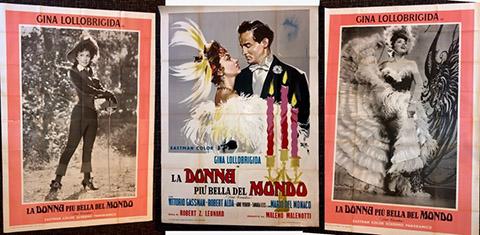
Hannah Tran is a student assistant working on the "Inventing Hollywood: Preserving and Providing Access to the Papers of Renegade Genius Howard Hughes" joint project sponsored by the UNLV Libraries Special Collections and Archives and the UNLV Department of Film, which is funded by a generous grant from the National Endowment for the Humanities.
Classical Hollywood cinema emerged from the introduction of sound films in the 1920s and the consumer demand for escapism during the Great Depression. One of this era’s main characteristics, its vertically-integrated studio system, allowed a small number of film studios to control the production as well as the distribution of films. This system enabled studios to enforce rigid contracts on the actors who helped create their success.
The Howard Hughes Motion Picture Papers (MS-01036) at UNLV Special Collections and Archives provides a deep look into this period of film history and the major figures at its heart. A perfect example of the inequality within Hollywood at the time is the combative relationship between high-profile Italian actor Gina Lollobrigida and her longtime admirer, Howard Hughes. Hughes controlled one of the “big five” film studios, RKO, and in 1950, Hughes’ invitation to Lollobrigida to perform a screen test for RKO spiraled into a strict seven-year contract which made it unreasonably expensive for any other American studio to hire her.
Lollobrigida then chose to work around the contract’s terms, using a loophole to work in American and European films shot outside of the United States. One of these productions was 1955 French-Italian film, La donna più bella del mondo, or, The Most Beautiful Woman In the World. In this film, she portrayed the Italian opera soprano, Lina Cavalieri.
The Howard Hughes Motion Picture Papers contains numerous materials documenting the film, including behind-the-scenes photographs, film stills, pamphlets, magazines, pressbooks, critic’s reactions, and advertising posters.
It also contains memorandums addressed to Hughes outlining changes in the contract conditions between RKO and Lollobrigida. These conditions are sometimes shocking, such as Lollobrigida’s initial compensation set at $173,333 per picture - equivalent to about $1,963,503 today. They can also be insightful, such as with the extremely specific demands regarding the size of Lollobrigida’s name in the credits or what type of roles and genres she refused to do.
These materials provide greater context concerning Lollobrigida’s frustration with Hughes’, as well as their persistent legal battles, making it impossible for her to work on a film in the United States until four years after Hughes left RKO.
Some materials also provide a window into the larger social and economic factors during that time. For example, the Howard Hughes Motion Picture Papers collection contains an adaptation of The Most Beautiful Woman In the World into a Cineromanzi, a popular type of post-WWII magazine that adapted films into comic-style stories. These magazines are considered an important indicator of the Americanization of Italy and the people’s methods to deal with Italy's struggling financial situation.
Funding by the National Endowment for Humanities allows UNLV Special Collections to conserve and archive these important historical materials. Through the Howard Hughes Motion Picture Papers, researchers can explore the evolution of the Golden Age of Cinema’s studio system and how it affected individuals like Gina Lollobrigida. Those interested in filmmaking, film history, European history, labor equality, and film law will certainly find appeal in the vast perspectives The Howard Hughes Motion Picture Papers collection has to offer.

About the National Endowment for the Humanities
Created in 1965 as an independent federal agency, the National Endowment for the Humanities supports research and learning in history, literature, philosophy, and other areas of the humanities by funding selected, peer-reviewed proposals from around the nation. Additional information about the National Endowment for the Humanities and its grant programs is available at: www.neh.gov.


